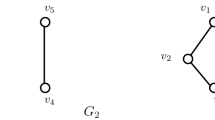Abstract.
A stable set in a graph G is a set of pairwise nonadjacent vertices. The problem of finding a maximum weight stable set is one of the most basic ℕℙ-hard problems. An important approach to this problem is to formulate it as the problem of optimizing a linear function over the convex hull STAB(G) of incidence vectors of stable sets. Since it is impossible (unless ℕℙ=coℕℙ) to obtain a “concise” characterization of STAB(G) as the solution set of a system of linear inequalities, it is a more realistic goal to find large classes of valid inequalities with the property that the corresponding separation problem (given a point x *, find, if possible, an inequality in the class that x * violates) is efficiently solvable.¶Some known large classes of separable inequalities are the trivial, edge, cycle and wheel inequalities. In this paper, we give a polynomial time separation algorithm for the (t)-antiweb inequalities of Trotter. We then introduce an even larger class (in fact, a sequence of classes) of valid inequalities, called (t)-antiweb-s-wheel inequalities. This class is a common generalization of the (t)-antiweb inequalities and the wheel inequalities. We also give efficient separation algorithms for them.
Similar content being viewed by others
Author information
Authors and Affiliations
Additional information
Received: June 2000 / Accepted: August 2001¶Published online February 14, 2002
Rights and permissions
About this article
Cite this article
Cheng, E., de Vries, S. Antiweb-wheel inequalities and their separation problems over the stable set polytopes. Math. Program. 92, 153–175 (2002). https://doi.org/10.1007/s101070100267
Issue Date:
DOI: https://doi.org/10.1007/s101070100267




